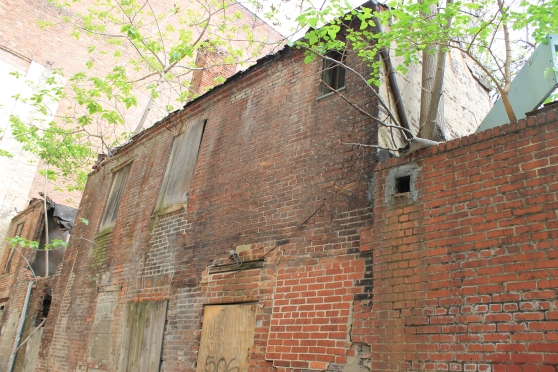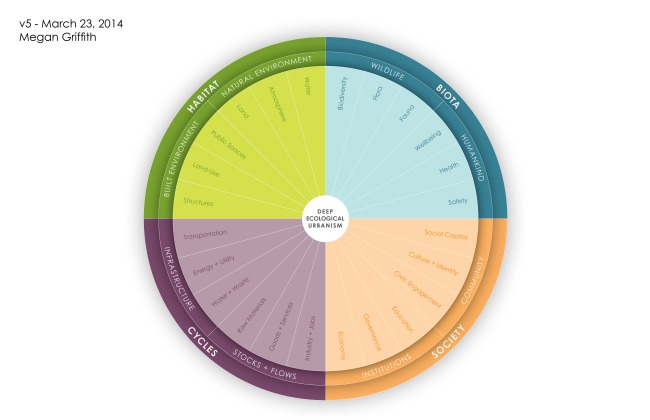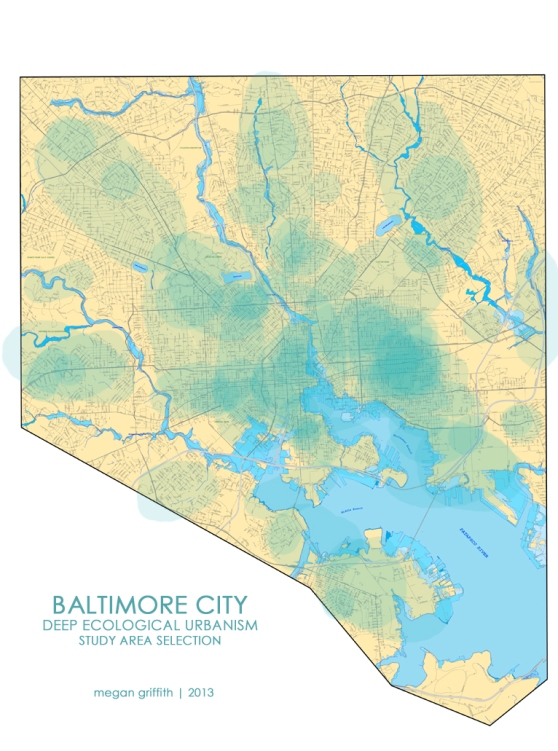I have concluded Unit One | Humans v. Nature, and I’m finishing up Unit Two | Deep Ecology this weekend. There are a few more Deep Ecology readings that I’ll be getting into; however, I think now is a good point to review the two units before I delay that process any longer.
Let me begin by reviewing [Unit 1 | Human v. Nature]. The first core concept that I wanted to cover was the meaning of the term sustainable and how it differed from ecological. It would seem that the word “sustainable,” in recent times, is thrown into every conversation where it might even remotely apply. I suppose this is a good thing, as it would imply people are generally more aware of the concept and its significance; but as many writers have already investigated (Campbell, Van der Ryn & Cowan, et al), perhaps the word has become too broad. It has certainly been “greenwashed” and cheaply used as a marketing spiel. Yet I’ve been dissatisfied with word lately because it doesn’t fully express my hopes for cities. Of course, I want cities to be sustainable, but it’s the ecological leg of the sustainability stool which I want to encourage most enthusiastically. Knowing that the terms ecological and sustainable would have related, but varied implications for cities, I wanted to investigate their comparison some more. I would have to say Van der Ryn and Cowan presented the best discussion, citing David Orr’s separation of sustainability into two separate categories: technological and ecological. Furthermore, this discussion opened up an entirely new debate about remedy and prevention. Clearly, as we approach the health and sustainability (in all three senses of the word) in cities, we need to be proactive rather than reactive.
I intended to also review issues of climate change, environmental degradation, and resiliency in this first unit, yet I only briefly touched upon those subjects. A common theme tying them together is that conflict of humans versus the Earth. Our societies and cultures have come to be so anthropocentric. We tend to feel that humans hold a special place in nature and conduct our affairs entirely around human wants and needs; there is an unexplainable need to overcome nature. While this usually awards us a sense of power on the surface, we are ultimately humbled by the power of Mother Nature herself. By channeling a river into a culvert, for example, we disrupt countless natural relationships and interactions. In many instances where we’ve ignored the rules of nature, we suffer the consequences down the road. These consequences are expensive annoyances at best, but devastating and lethal events at worst. Climate change can at least partly be attributed to our own actions and, therefore, the more frequent and intense weather events which have so unfortunately razed cities and taken lives can largely be seen as our own doing. It is easy to blame nature for such catastrophes, but we should not so easily accept such events as natural.* But on the more menial scale of things, we have also forced ourselves into the tedious role of manager. We are forced to manage “pests”; meanwhile, the number of creatures which we categorize as pests increases daily. Deer, for example, are such passive creatures. But as we take over more and more of their land and kill off their primary predators, we are left to “manage” their population on our own. Aldo Leopold recognized it back in the 1940s: predators are needed to maintain the balance of the “wilderness.”
I was young then and full of trigger-itch; I thought that because fewer wolves meant more deer, that no wolves would mean hunters’ paradise. But after seeing the green fire die, I sensed that neither the wolf nor the mountain agreed with such a view.” Aldo Leopold, Thinking Like a Mountain
This idea is not limited to the wilderness; our cities are very much in need of the same balance. It’s a controversial subject that I don’t know enough about, but some areas have long considered the reintroduction of predator species to help control pest populations. In other places, like where I grew up, humans gladly accept the role of hunter. To clarify again, however, this issue is not related to the wilderness, nor does it only apply to predators and their game.
In a similar situation, we are left to deal with invasive plant and animal species. We pour chemicals on weeds (which are often just undesirable native plants) and feel a constant need to address the invasive species which so effortlessly kick out the native plants. An interesting and related aspect of nature that I really wanted to investigate in more detail is resiliency. As humans, we are so determined to fight back, but if we look away for more than a second, nature has already begun to reclaim a previously urbanized environment (and it’s why I sometimes secretly root for invasives). If the city is ignoring a crumbling building, you can bet that nature isn’t: nests in the eaves, vines up the walls, dens inside the empty structure… Clearly, if we don’t intend to make room for nature in our cities, nature will find its own way in.

Nature steps in; The owner could care less about this structure
For the introductory units, I also wanted to think of the 4W’s and 1H of Ecological Urban Design: who|what|where|when|why|how. While most readings actually did not make the urban connection (at least related to design or form) with the concepts they reviewed, I was still able to develop my own answers. The whos, wheres, and whens can best be summarized in a timeline that I’ve been slowly building to include relevant events. This product will be shared upon completion of the course. But the whats, whys, and hows are, I think, more interesting questions that can be talked about at some length. What exactly is ecological urban design, why do we need it, and how do we implement it? Obviously, these questions will not be fully answered until the end of the course (and even then, I expect much will be left unanswered), but I intend to address them in each unit along the way. The first unit, Human v. Nature, made me interpret my own answers. Although nothing was spelled out in the text, reviewing what was NOT ecological urban design (crowded and dirty cities, excessive use of resources, universal and boring, concrete jungles/gardens, and so on) has given me a better idea of what ecological urban design should be; that is: open, healthy, green, local, and so on and so forth.
This is a good segue into [Unit 2 | Deep Ecology]. A lot of what should inform ecological design depends on our society’s view of ecology in general. The Deep Ecology perspective sees the human being within and as part of the larger ecosphere, and not simply as an independent entity that inhabits it [Bettercities.net]. This perspective paints a picture of Ecological Urban Design.
Before I opened any book for this course, I composed my own definition of Deep Ecological Urbanism:
Deep Ecological Urbanism is a form of urban design that acknowledges the importance of all species as well as the interconnectivity between all living things. Systems are designed to have minimal adverse impact- or even a positive gain- and operate so that all living forms in the city are given an opportunity to thrive.
At this stage of my study, my understanding of the “Ecological City” is still very theoretical. My definition, still, is evolving. Deep Ecological Urbanism is a design where humans recognize the non-human world of our environment. Values must come into play; however, they are not to be perceived based on the usefulness for human purposes. Rather, a biocentric belief holds that all creatures have rights and values; it is also the center of much environmental-ethical debate: is value inherent in all things? I certainly think so. Deep Ecological Urbanism recognizes the importance of biodiversity, and thus, development should not limit another organism’s ability to flourish. Informed by the principles and successes of Public Health Reform, the Urban Parks Movement, Garden Cities, and City Beautiful among many other tenets and movements, Deep Ecological Urbanism reintroduces nature into our cities. I’m eager to see how this definition will evolve more!
—
*I don’t want to go into detail on this topic right now, but for a more clearly articulated expression of this idea, I strongly recommend Neil Smith’s short essay, There’s No Such Thing as a Natural Disaster.










